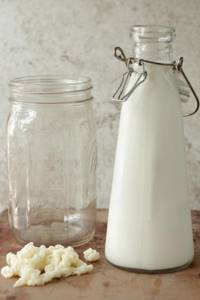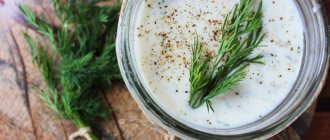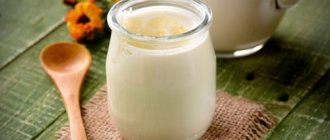Kefir means “to feel good” in Turkish. Surely it was no coincidence that this fermented milk drink was given such a name. We propose to understand and collect scientific facts and studies that reliably reveal the whole truth about the properties of kefir.
Like 1
425
Kefir is produced by ripening (fermentation). Due to this process, it contains probiotics and prebiotics. Probiotics are strains of yeast and bacteria that are essential for healthy gastrointestinal and immune system function. Prebiotics are carbohydrates that are not digested by the gastrointestinal tract and serve as food for probiotics. And yet, due to fermentation, kefir contains fewer antinutrients - substances that prevent our intestines from absorbing minerals and nutrients.
Why is kefir useful?
Kefir is a traditional product of our diet and a powerful digestive stimulant. The most important beneficial property of fermented milk drink is that it contains beneficial lactic acid bacteria. The acidic pH environment and lactic acid bacteria (lactocultures of prebiotics, very similar to the natural intestinal microflora) help to digest well not only kefir itself, but also other foods.
Kefir is a fermented milk product, which means it contains bacteria similar to those that live in the microflora of the human stomach.
Read about the results of kefir research by Roskachestvo experts HERE
Kefir has a beneficial effect on the functioning of the cardiovascular and nervous systems, and it is also a source of calcium and protein. Milk proteins in kefir are absorbed by the body very easily. At the same time, kefir is a low-calorie product.
Kefir contains many useful substances:
- milk protein, fats, organic and fatty acids, natural sugars;
- vitamins – A, PP, beta-carotene, C, H, 8 B vitamins;
- minerals - calcium, magnesium, sodium, potassium, phosphorus, chlorine, sulfur, iron, zinc, iodine, copper, manganese, selenium, chromium, fluorine, molybdenum, cobalt.
Kefir strengthens the immune system
Doctors recommend and even prescribe kefir to weakened patients so that they quickly get stronger and gain strength. The immunoregulatory properties of kefir were confirmed by the results of studies conducted by scientists at the Ankara Education and Research Hospital. 18 volunteers aged 20-40 years were given kefir to drink for 2 weeks: as a result, activation of large leukocytes (macrophages) was discovered.
The properties of kefir to positively influence the immune system were discovered in mice by scientists at the Canadian University of Moncton. They conducted a series of studies, as a result of which the animals' resistance to intestinal infections increased and the number of cells with immunoglobulin A (IgA) antibodies in the small and large intestines increased.
Is kefir better than milk?
Kefir as a drink is healthier than milk specifically for adults, since lactic acid bacteria not only activate intestinal motility and suppress pathogenic microorganisms, preventing fermentation and rotting from occurring, but also help digest casein (cow's milk protein) and promote the absorption of vitamins, calcium and iron.
Important!
Calcium from kefir is absorbed much better than from milk. Milk also makes iron absorption more difficult than kefir.
Kefir fights Helicobacter pylori
Scientists from the Uludag University Medical School (Turkey) studied the effect of kefir on Helicobacter pylori, a pathogenic bacterium that affects the stomach and duodenum, causing erosions, gastritis, adenocarcinoma, peptic ulcers and increases the risk of developing certain types of cancer. Scientists compared treatment with conventional therapy and with the addition of kefir to the diet. For 14 days, 82 patients received triple therapy (lansoprazole, 30 mg + amoxicillin, 1000 mg + clarithromycin, 500 mg) and were given 250 ml of kefir 2 times a day. According to test results, this treatment was more effective in killing Helicobacter pylori than triple therapy alone.
Precautionary measures
- You should not drink more than 3 glasses of kefir per day - this fermented milk product, consumed in large quantities, exhibits a laxative effect;
- People suffering from some forms of gastritis (increases acidity) should avoid drinking the drink.
An excellent student from Moscow has invented a fat burner! 12 cm in the waist goes away in a week if mixed with kefir...
More details
Revolutionary technology for losing weight at home. Lose excess weight without dieting or training! In just 23 minutes a day.
Buy
Age-related fat does not come from food! You will lose 22 kg of fat in a week if you drink 150 ml of hot water on an empty stomach...
More details
Harm and contraindications
Like any product, kefir has its drawbacks, and eating it does not always have a positive effect on health. The drink is contraindicated if you have:
- Gastritis or ulcer with high acidity.
- Poisoning or gastrointestinal infection.
Due to the fact that kefir contains alcohol, bacteria die in it over time and it only causes fermentation processes in the intestines. Low-fat kefir is not recommended for consumption at all; due to the lack of fat, most of the beneficial elements are simply not absorbed.

How does drinking kefir affect the body?
Regardless of what time of day or night you drink kefir, it will always perform the following functions:
- Elimination of dehydration and swelling.
- And you can drink it even if you are allergic to lactose, when there is no way for milk. The product is low-allergenic and useful even for children.
- Reduces the level of “bad” cholesterol in the blood.
The healthiest kefir is with 2.5% fat content, it is ideal for those losing weight and for those who maintain their weight.

What causes weight loss on kefir?
Why weight loss and not diet? First of all, let's define what a diet is. It's just a diet. And weight loss is a reduction in body weight due to water, fats or even proteins (muscles).
You can lose weight on kefir, but besides it you should also consume other products. The body will experience enormous stress and should be supported with vitamins and complex carbohydrates. And yes, you should use full-fat kefir; low-fat kefir will not help much. So the healthy fats that are missing in it will not remove the bad fats.
In weight loss, kefir plays the role of support, not the main dish. You should not “go on a kefir diet” that contains only one product. Not only will you not lose weight, but you will also worsen your health.
How to distinguish “live” kefir from “dead” | Nutrition and diets | Kitchen
Each of us drinks an average of 21.5 liters of kefir during the year. If you suddenly fall out of this statistics, urgently correct the situation, because Russian fermented milk drink is the path to beauty and health! Just don’t confuse “live” kefir with its useless fake in the store. Alas, there are a lot of the latter on our shelves.
Nowadays, it has become fashionable to consume yoghurts and other Western fermented milk drinks to improve microflora and protect the immune system. But some products can’t even hold a candle to native kefir! Judge for yourself: if in ordinary yogurt there are a maximum of 3-5 types of beneficial microorganisms, then in kefir there are more than 20 of them. Moreover, these are not only bacteria, but also fungi that have created a unique symbiosis among themselves called “kefir starter”. Thanks to their coordinated work, the fermented milk drink restores the intestinal microflora after taking medications, cleanses the body of toxins, improves digestion, strengthens the immune system, normalizes metabolism and thereby helps to lose weight. If you listen to the opinion of nutritionists and start consuming kefir regularly, within a month you will notice tangible results both on the face and in the waist area. The main thing is not to make a mistake with your choice and drink a “live” drink.
Natural and healthy
The history of kefir is akin to a real detective story. According to one version, the secret leaven was stolen in Persia; according to another, it was obtained through blackmail in the Caucasus. Be that as it may, in 1909, industrial production of fermented milk drink began in Russia, and now it has officially acquired the status of a national Russian product. By the way, modern bacteria and fungi are descendants of ancient organisms, because the only way to obtain them is direct reproduction (scientists have still not been able to breed them again). Maintaining the vital activity of the starter is quite difficult, so not every enterprise can manage the production of real kefir. In a simplified way, the technology for its production is as follows: milk is disinfected by pasteurization, then in a sterile room at a certain temperature and humidity, a starter is added to it, thanks to which lactic acid and alcohol fermentation begins. Its result is a “live” snow-white fermented milk drink, familiar to us from childhood. It's easy to recognize it on the counter. First, look carefully at the name of the product - it should simply be called “kefir”. Then read the ingredients - the list of the classic white drink contains only two ingredients: milk (preferably whole or normalized, not dry) and kefir grain starter. After this, look on the label for information about the presence of living flora: “The number of lactic acid microorganisms at the end of the product’s shelf life is at least 1x10 to the 7th power CFU/g. The amount of yeast at the end of the product’s shelf life is at least 1x10 to the 4th power CFU/g.” And finally, another distinctive feature of “live” kefir is its shelf life is no longer than 14 days. If the drink can be stored longer, it means that it has been subjected to heat treatment (preservatives in kefir are generally prohibited) and has lost its beneficial essence.
Product a la kefir
Unfortunately, recently many products a la kefir have appeared on our shelves. It is made not with live sourdough, but with the help of dried bacteria: they take the powder and pour it into pasteurized milk. The result is a drink that tastes very much like kefir, but in essence is completely different from it. According to the law, it does not have the right to be called kefir, so it is most often called “kefir product”, “kefir”, “kefir ...” and so on. To pass off your product as valuable fermented milk, use capital letters, and add the ending “ny” or “naya” in small print. In addition, there will be no quantitative indicators of microorganisms and yeast on the packaging of a “dead” dairy product and there will be no starter in the composition. And part of the milk in the “non-live” version can be replaced with vegetable palm fat. Such kefir drinks, although safe for health, will not bring benefits to the body.
GOST, STR or TU?
Natural “live” kefir today is protected by two technological documents - GOST R 52093 and the recently adopted technical regulations on milk and dairy products, which are indicated on the label with a three-letter icon - STR (although it is often difficult to see). However, a drink can be made according to specifications and at the same time turn out to be “more alive than all living things.” This happens when the manufacturer adds sugar, fruit or juice to a natural fermented milk product - unlike classic kefir, children drink sweet fruit with great pleasure, and such a drink is also very healthy. GOST does not provide for such additives, so in this case, do not be confused by the technical specifications. The main thing is that the label contains other signs of a “live” drink.
Diet or whole milk?
So that you can choose kefir with the required fat content, before fermentation the milk is normalized, that is, it is brought to a certain standard (not to be confused with powdered milk!). The cream is separated from the milk and then mixed with it in the required proportions, achieving 0%, 0.5%, 2.5% or 3.2%. However, kefir can also be made from whole milk. It is not subjected to normalization and is fermented in its original form, obtained from a cow. Therefore, the fat content of such fermented milk drink varies from 3 to 4%. If you want to know a more specific figure, look at the cardboard “comb” of the package or the bottle cap - there the manufacturer usually indicates the batch of kefir and its mass fraction of fat.
Mature and immature
Classic kefir, made according to all the rules, must have a snow-white color and a uniform consistency with or without a broken clot: in order to “break it”, it is recommended to shake the drink before use. A quality product has a clean, slightly pungent, pinching taste. However, this is the only milk drink that can change over time. It’s all due to the vital activity of microorganisms, so in the first days kefir is soft and tender, and by the end of the shelf life it becomes more and more pungent, sour and pungent. Technologists even have the concepts of “mature” and “immature” product. This drink is also characterized by slight gas formation and the presence of alcohol: yeast ferments milk sugar - lactose and produces alcohol, although in very small quantities (up to 1%). Normally, such processes are good, but if bacteria “rage” due to improper storage, they will quickly turn healthy kefir into a dangerous drink. To avoid risking your health, buy a product that is stored in the refrigerator and avoid “swollen” containers. Which packaging option you choose: glass or polymer bottles, Tetra Pak boxes or cups is a matter of taste. The main thing is not to use kefir for future use and do not leave it open in the refrigerator, otherwise foreign bacteria will penetrate into it, and milk protein absorbs odors, and the aroma of garlic or onion will definitely get into the drink. And most importantly, try to use the product before its expiration date - experts say that even the next day kefir becomes dangerous.
| Ideal classic kefir | |
| 1. Called “kefir”. | |
| 2. Has the certification mark STP and GOST R 52093. | |
| 3. Made from two ingredients: milk and kefir grain starter. | |
| 4. The number of lactic acid microorganisms at the end of the product’s shelf life is at least 1x10 to the 7th power CFU/g. The amount of yeast is at least 1x10 to the 4th degree CFU/g. | |
| 5. Snow-white, with a clot broken or not and a pure kefir taste: slightly spicy, pinching and without any foreign odors. | |
| 6. Light gas formation and the presence of alcohol up to 1% are acceptable. | |
| 7. Has a shelf life of no more than 14 days. | |
See also:
A little history
Previously, in the Caucasus, kefir was considered a real gift from heaven, the secret of which Caucasians did not trust to anyone. Today we already know that this wonderful product is made from special fungi, which give it truly healing properties. It was kefir starter that had the highest value for the highlanders, so many specific rituals and ceremonies were associated with it. The most bizarre thing is that it was impossible to sell the starter to someone, otherwise the fungi would lose their magical properties. Therefore, “kidnappings” were quite common - when people who needed fungi, the owners themselves offered to steal them unnoticed, and only after that the kidnapper brought the appointed amount to the owner of the “miracle grains.” They could also be given as a dowry to a girl, but the bride, on the eve of the wedding, also had to steal them in order to bring them to her new family.
Results
Kefir is a low-calorie drink that contains beneficial bacteria that have a beneficial effect on the functioning of the intestines and digestion in general. With the help of kefir, you can lose weight, cleanse the body of toxins and impurities, improve overall well-being and get rid of puffiness.
The drink is useful to drink in the morning on an empty stomach and before bed. It can be consumed either alone or together with other ingredients, for example, buckwheat, flaxseeds, oatmeal, cinnamon, etc. Kefir is useful to drink after sports to saturate the body with energy, satisfy hunger and strengthen muscle tissue.
Composition and calorie content of kefir of different fat contents
The most beneficial for human health is kefir with a low fat content, but not completely fat-free, namely 1%. The chemical composition of drinks of different fat content (1%, 2.5%, 3.2%) is similar in the content of nutrients and beneficial bacteria, but differs in the amount of cholesterol.
Calorie content of kefir per 100 g:
- 1% – 40 kcal;
- 2.5% – 53 kcal;
- 3.2% – 59 kcal;
- 0% (low fat) – 38 kcal;
- 2% – 50 kcal;
- homemade - 55 kcal;
- with sugar – 142 kcal;
- with buckwheat – 115.2 kcal;
- with oatmeal – 95 kcal;
- pancakes with kefir – 194.8 kcal;
- pancakes – 193.2 kcal;
- okroshka – 59.5 kcal;
- manna – 203.5 kcal.
How much water is in kefir – Popular diets
Source: frs24.ru
| Milk 1.5% | 89.9 g |
| Shiitake mushrooms | 89.7 g |
| Morel mushroom | 89.6 g |
| Grapefruit juice | 89.6 g |
| Turnip | 89.5 g |
| Porcini mushrooms | 89.4 g |
| Watercress (greens) | 89.4 g |
| Broccoli | 89.3 g |
| Oyster mushroom | 89.2 g |
| Kumis (mare's milk) | 89.1 g |
| Pomelo | 89.1 g |
| Cherry plum | 89 g |
| Varenets 2.5% | 89 g |
| Kefir 2.5% | 89 g |
| Milk 2.5% | 89 g |
| Yogurt 2.5% | 89 g |
| Camelina mushroom | 88.9 g |
| Cranberry | 88.9 g |
| Low-fat kumiss (from cow's milk) | 88.9 g |
| Grapefruit | 88.8 g |
| Ryazhenka 2.5% | 88.8 g |
| Fern | 88.7 g |
| Chanterelles | 88.5 g |
| Acidophilus 3.2% | 88.4 g |
| Milk 3.2% | 88.4 g |
| Kefir 3.2% | 88.3 g |
| Curdled milk 3.2% | 88.3 g |
| Orange juice | 88.3 g |
| Dry wines (white and red) | 88.2 g |
| Boletus mushrooms | 88.1 g |
| Milk 3.5% | 88.1 g |
| Apple juice | 88.1 g |
| Blackberry | 88 g |
| Leek | 88 g |
| Mandarin | 88 g |
| Carrot | 88 g |
| Sea kale | 88 g |
| Papaya | 88 g |
| Black radish | 88 g |
| Swede | 87.8 g |
| Lemon | 87.8 g |
| Tangerine juice | 87.8 g |
| Blueberry | 87.7 g |
| Celery (root) | 87.7 g |
| Nectarine | 87.6 g |
| Strawberries | 87.4 g |
| Ryazhenka 4% | 87.4 g |
| Chicken egg white | 87.3 g |
| Goat milk | 87 g |
| Orange | 86.8 g |
| Yogurt 1.5% | 86.5 g |
| Yogurt 3.2% | 86.3 g |
| Plum | 86.3 g |
| Apples | 86.3 g |
| Apricot | 86.2 g |
| Kohlrabi cabbage | 86.2 g |
| Peach | 86.1 g |
| Cowberry | 86 g |
| Brussels sprouts | 86 g |
| Bulb onions | 86 g |
| Beet | 86 g |
| Blueberry | 86 g |
| Cherries | 85.7 g |
| Dandelion leaves (greens) | 85.6 g |
| Dill (greens) | 85.5 g |
| White currant | 85.4 g |
| A pineapple | 85.3 g |
| Ryazhenka 6% | 85.3 g |
| Pear | 85 g |
| Parsley (greens) | 85 g |
| Red currants | 85 g |
| Pineapple juice | 85 g |
| Cherry juice | 85 g |
| Gooseberry | 84.7 g |
| Raspberries | 84.7 g |
| Carrot juice | 84.6 g |
| Cherry | 84.4 g |
| Apricot juice | 84.3 g |
| Quince | 84 g |
| Cream 8% | 83.9 g |
| Acidophilus 3.2% sweet | 83.8 g |
| Kiwi | 83.8 g |
| Yogurt 6% | 83.5 g |
| Mango | 83.5 g |
| Cloudberry | 83.3 g |
| Black currant | 83.3 g |
| Feijoa | 83.3 g |
| Fresh figs | 83 g |
| Sea buckthorn | 83 g |
| Parsnip (root) | 83 g |
| Parsley (root) | 83 g |
| Beetroot juice | 83 g |
| Oyster | 82.7 g |
| Pomegranate juice | 82.5 g |
| Cod | 82.1 g |
| Mussels | 82 g |
| Cream 10% | 82 g |
| Sour cream 10% | 82 g |
| Peach juice | 82 g |
| Pollock | 81.9 g |
| Grape juice | 81.9 g |
| Persimmon | 81.5 g |
| Yogurt 3.2% sweet | 81.3 g |
| Haddock | 81.1 g |
| Red rowan | 81.1 g |
| Pomegranate | 81 g |
| Crayfish | 81 g |
| Grape | 80.5 g |
| Rowan chokeberry | 80.5 g |
| Green peas (fresh) | 80 g |
| Hake | 79.9 g |
| Flounder | 79.7 g |
| Pike | 79.3 g |
| River perch | 79.2 g |
| Zander | 79.2 g |
| Beef kidneys | 79 g |
| Jerusalem artichoke | 79 g |
| Ginger (root) | 78.9 g |
| Potato | 78.6 g |
| Yogurt 6% sweet | 78.5 g |
| Vobla | 78.2 g |
| Yogurt 1.5% fruit and berry | 78.1 g |
| Carp | 78 g |
| Low-fat cheese | 78 g |
| Navaga | 77.9 g |
| Sour cream 15% | 77.5 g |
| Bream | 77.4 g |
| Sea bass | 77.1 g |
| Horseradish (root) | 77 g |
| Halibut | 76.9 g |
| Som | 76.7 g |
| Squid | 76.4 g |
| Sweet corn | 76 g |
| Horse mackerel | 75.6 g |
| Salaka | 75.4 g |
| Shrimp | 75.3 g |
| Baltic sprat | 75 g |
| Chum salmon | 74.2 g |
| Chicken egg | 74.1 g |
| Banana | 74 g |
| Quail egg | 73.2 g |
| Lean herring | 72.9 g |
| Cream 20% | 72.8 g |
| Sour cream 20% | 72.8 g |
| capelin | 72.6 g |
| Cottage cheese 2% | 72.6 g |
| Avocado | 72 g |
| Pink salmon | 71.8 g |
| Beef liver | 71.7 g |
| Low-fat cottage cheese | 71.7 g |
| Sturgeon | 71.4 g |
| Atlantic salmon (salmon) | 70.6 g |
What are the benefits of fermented milk drink for expectant mothers?
For many women suffering from toxicosis during the first stages of pregnancy, kefir is the best drink for every day. Unpleasant for pregnant women is the presence of heartburn after eating. Heartburn occurs against the background of a hormonal imbalance in a woman’s body, which provokes an increase in the acidity of gastric juice. To minimize the feeling of heartburn, you should consume fermented milk products and kefir, but for this, a pregnant woman should consume it fresh and on an empty stomach. In the last stages of pregnancy, kefir will also help with constipation, when the fetus puts pressure on the intestines and stomach and prevents good digestion, because. it breaks down the complex protein casein.
The cardiovascular system is also normalized, thanks to the uniform supply of glucose into the blood from kefir. Should pregnant women drink kefir at night? It depends on the woman herself, but we can confidently say that it will be useful. It turns out that kefir is very useful for expectant mothers, but it should be consumed in moderation.










